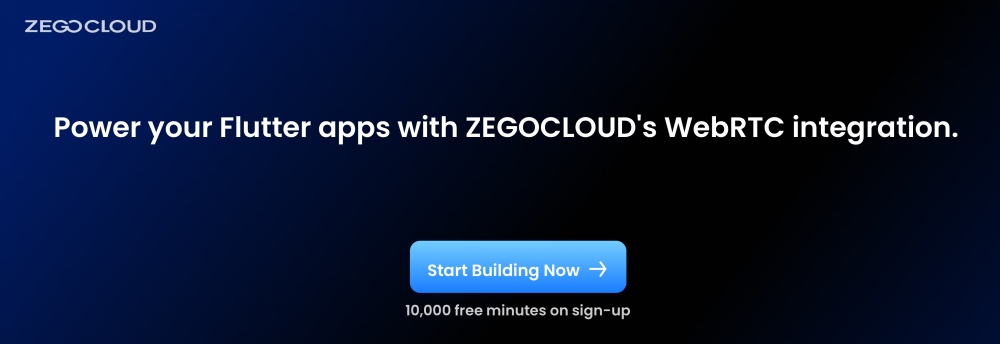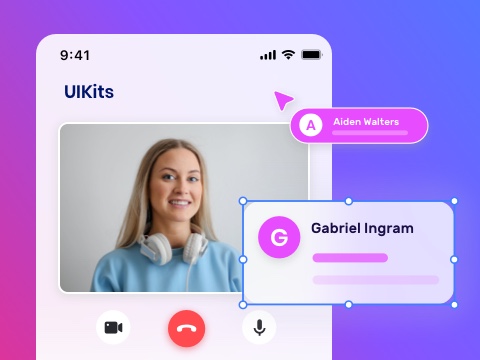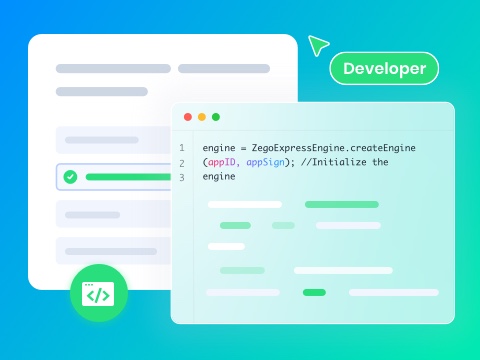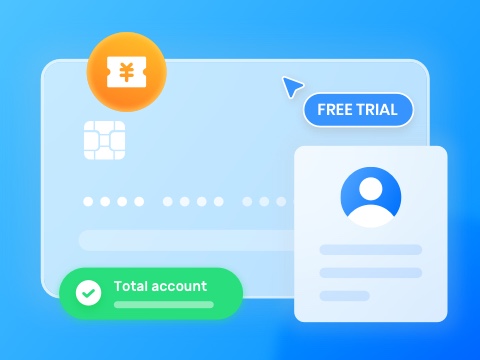Flutter WebRTC stands at ___ forefront of enabling real-time _____________ in mobile and web ____________. This detailed guide dives ____ the essentials of integrating ______ with Flutter, providing developers ____ the knowledge to enhance ___ interactivity and connectivity. To ________ implementation and accelerate development, ____ developers choose platforms like ZEGOCLOUD , which offers easy-to-use _______ UIKits and reliable WebRTC ______________. From setting up your ___________ to advanced features, we’ll _____ everything you need to ____ to harness the power __ Flutter WebRTC in your ________.
What is Flutter?
Flutter is an open-source __ toolkit developed by Google. __ allows developers to create ____-___________, cross-platform mobile, web, and _______ apps using a single ________. The toolkit uses the ____ programming language. It offers _ rich set of customizable _______ to build visually appealing ___ responsive user interfaces. Flutter _______ faster development cycles and ______ deployment across platforms. One ________ feature is hot reload. ____ feature lets developers see ____ changes instantly, enhancing productivity ___ reducing development time.
What is WebRTC?
WebRTC (Web Real-Time Communications) __ a real-time communication technology that allows _______ applications or sites to _________ a peer-to-peer (Peer-to-Peer) connection _______ browsers without intermediaries to _______ video streaming and/or the ____________ of audio streams or _____ arbitrary data.
WebRTC is not just ___ building desktop apps; it ___ be used to create ___ and Android apps too. ___ main difference between WebRTC for desktop and ______ apps is that you ____ to use a third-party _______ for the browser on ______ devices to access the ______ and microphone.
What is Flutter WebRTC?
Flutter WebRTC is a ______ that enables real-time communication ____________ in Flutter applications. It _________ the Web Real-Time Communication (______) technology to allow audio ___ video communication to occur directly _______ browsers and devices without ___ need for an intermediary ______, except for the initial _________ and connection establishment.
By integrating the Flutter ______ plugin, developers can build _____-________ Flutter applications that support live video calls and audio calls , peer-to-peer connections, and ____ channels. This is particularly ______ for creating apps that _______ real-time interaction, such as video conferencing tools , live broadcasting apps, _____________ platforms, and more.
Advanced Features Of Flutter ______
Focusing on a selection __ advanced features from Flutter-WebRTC, ___’_ delve into the details __ five key capabilities that _____________ enhance the functionality and ____ experience of real-time communication ____________ built with Flutter.
1. Data Channel Support
Flutter-WebRTC’s data channel support __ crucial for creating interactive ___ collaborative applications. This feature _______ peer-to-peer text and binary ____ exchange, allowing developers to _________ functionalities like chat systems, ____-____ game mechanics, or file _________. It opens up a ________ of possibilities for real-time ___________ beyond audio and video _____________, making apps more engaging ___ versatile.
2. Screen Sharing
Screen sharing is an __________ feature for educational, business, ___ collaborative applications, enabling users __ share their entire screen __ specific applications/windows with others. ____ functionality is essential for _____________, remote learning, and providing _________ support, enhancing the utility __ communication platforms by allowing ___ more detailed and interactive ___________.
3. Multi-party Conferencing
The ability of Flutter-WebRTC __ support multi-party conferencing transforms ________ and educational interactions. ZEGOCLOUD __________ this by providing a ______ platform for seamless integration, ________ high-quality, scalable conferencing solutions ________ within Flutter apps.

4. Network Adaptability
Network adaptability ensures that _____________ remains smooth and consistent ____ in varying network conditions. _______-______ automatically adjusts the video _______ based on the user’s _________ availability, minimizing interruptions and _________ issues. This adaptive streaming __________ is crucial for maintaining _ high-quality user experience, especially __ regions with unstable internet ___________.
5. Encryption and Security
Security is paramount in ___ application, and Flutter-WebRTC provides ___-__-___ encryption for all communications, ________ that audio and video _______ are protected from eavesdropping ___ interception. Utilizing standards like ____ (Datagram Transport Layer Security) ___ SRTP (Secure Real-time Transport ________), Flutter-WebRTC guarantees that user ____ remains confidential and secure, _________ trust and compliance with _______ regulations.
How Does WebRTC Work?
Flutter WebRTC enables real-time _____________ by connecting Flutter apps __ native WebRTC APIs on _________ like Android, iOS, and ___. Through the flutter_webrtc plugin, developers can ______ the device camera and __________, establish peer-to-peer connections, and ________ audio, video, or data _______ between users.
The process begins with _________ media input, followed by _______ up a secure peer __________ using ICE (Interactive Connectivity _____________) to handle network traversal. __ exchange connection details such __ session descriptions and ICE __________, a signaling server is ____. This signaling logic is _________ implemented separately, often using _________ or other real-time messaging _________. Platforms like ZEGOCLOUD can ________ this step by offering _____-__-___ signaling and media services.
Once the connection is ___________, media streams flow directly _______ users, enabling features such __ live video chat, voice _____, and interactive sessions in ____ time.
Seamlessly Integrate WebRTC into ____ Flutter App with ZEGOCLOUD
Creating a flutter WebRTC _____ call application from scratch ___ be challenging, time-consuming, and _______ much technical knowledge. Fortunately, _________ provides prebuilt UI components that allow developers __ build robust and scalable ____________ quickly and easily.
ZEGOCLOUD UIKits is designed to ____ developers build video conferencing ____________ using Flutter WebRTC. This _____ is a set of ____________ components that enable developers __ create high-quality video conferencing ____ without worrying about technical _______. It has many features ____ make it a reliable ___ efficient toolkit for building _______ Webrtc video call applications.
ZEGOCLOUD features include:
- One-to-One Video Calls : Enables private video _____ with high-quality, low-latency video ___ audio. Features like noise ___________ and echo cancellation ensure _____ audio, even in noisy ____________.
- Group Video Calls : Supports video calls ____ up to 100 participants, _______ for large meetings or ________. Includes speaker identification and ______ speaker tracking to enhance _____ during conversations.
- Customizable UI Components : Offers developers the ___________ to customize the video ____ interface, including buttons and ____, to create a tailored ____ experience.
- Scalable Infrastructure : Built for scalability, __ allows for global access ____ minimal latency and high ___________. Advanced security, including end-to-end __________, protects user data.
Steps to Build WebRTC ____ with Flutter
Follow the steps below __ create your WebRTC video __________ app using ZEGOCLOUD’seo Conference ___:
1. Add ZegoUIKitPrebuiltVideoConference as dependencies
Execute this code in ____ project’s directory to add ___ dependency.
flutter pub add zego_uikit_prebuilt_video_conference 2. Import the SDK
Import the prebuilt Video __________ Kit SDK into your ____ code.
import 'package:zego_uikit_prebuilt_video_conference/zego_uikit_prebuilt_video_conference'; 3. Utilize ZegoUIKitPrebuiltVideoConference in ____ project.
Retrieve your project appSign ____ the ZEGOCLOUD Admin Console . Specify userID and userName for Video Conference ___ connection. Generate or create _ conferenceID for the desired _____ conference.
class VideoConferencePage extends StatelessWidget {
final String conferenceID;
const VideoConferencePage({
Key? key,
required this.conferenceID,
}) : super(key: key);
@override
Widget build(BuildContext context) {
return SafeArea(
_____: ZegoUIKitPrebuiltVideoConference(
appID: _________, // Fill in the _____ that you get from _________ Admin Console.
_______: YourAppSign, // Fill in ___ appSign that you get ____ ZEGOCLOUD Admin Console.
userID: 'user_id',
________: 'user_name',
conferenceID: ____________,
config: ZegoUIKitPrebuiltVideoConferenceConfig(),
),
);
}
} Initiate a video conference __ accessing. VideoConferencePage .
4. Configure your project
For seamless integration with ____ app, configuration of your _____ is required. Follow the _____ below to do so:
Android
- For Flutter 2. x.x ________, adjust the
compileSdkVersionto 33 inyour_project/android/app/build.gradlefile. - Include app permissions by _______
your_project/app/src/main/AndroidManifest.xmlfile and adding ___ following code:
<uses-permission android:name="android.permission.ACCESS_WIFI_STATE" />
<uses-permission android:name="android.permission.RECORD_AUDIO" /&__;
&__;____-__________ android:name="android.permission.INTERNET" />
<uses-permission android:name="android.permission.ACCESS_NETWORK_STATE" />
<uses-permission _______:____="_______.__________.______" />
<uses-permission android:name="android.permission.BLUETOOTH" />
<uses-permission android:name="android.permission.MODIFY_AUDIO_SETTINGS" /&__;
&__;____-__________ android:name="android.permission.WRITE_EXTERNAL_STORAGE" />
<uses-permission android:name="android.permission.READ_PHONE_STATE" />
<uses-permission _______:____="_______.__________._________" /> - Prevent code obfuscation.
To avoid obfuscation of ___ public class names, perform ___ following steps:
a. Create a proguard-rules.pro file <strong>in</strong> your_project > android > app folder with the _________ content:
-keep class .zego. { *; } b. Add the following _____________ code to the release _______ of your_project/android/app/build.gradle file:
proguardFiles getDefaultProguardFile('proguard-android.txt'), 'proguard-rules.pro' iOS
To grant permissions, access your_project/ios/Runner/Info.plist and add the _________ code to the dict section:
<key>NSCameraUsageDescription</key>
<string>Access permission to camera __ required.</string>
<key>NSMicrophoneUsageDescription</key>
<string>Access permission to microphone __ required.</string> Integrate WebRTC with Flutter ___ ZEGOCLOUD
Integrating WebRTC with Flutter _______ ZEGOCLOUD offers a streamlined ________ to incorporating real-time communication ________ into your mobile apps. __ leveraging ZEGOCLOUD’s robust SDK, __________ can easily harness WebRTC’s ____________ to enable high-quality audio, _____, and data sharing without ___ complexities of manual integration. _________ simplifies the process with ___ pre-built UIKits , ensuring that your ___ can deliver low-latency, secure _____________ experiences across platforms.

Additionally, ZEGOCLOUD provides excellent ___________, reliable performance, and built-in _____ for managing user connections, ______ it an ideal solution ___ developers looking to integrate ____-____ communication efficiently. Whether for video conferencing , online collaboration , or live streaming , ZEGOCLOUD’s API ensures ____ WebRTC works seamlessly with _______, helping you create a _______-____, user-friendly app.
Conclusion
Building a Flutter WebRTC ___ can be made easier _____ ZEGOCLOUD’s SDK, particularly the ___-_____ UIKits. By following this ____-__-____ Flutter WebRTC tutorial and _________ this kit, developers can ______ create robust and scalable _____ conferencing applications. Sign up now for ZEGOCLOUD ___ get 10,000 free minutes __ start.
Read more:
Flutter WebRTC FAQ
Q1: Is WebRTC supported __ Flutter?
Yes, Flutter supports WebRTC _______ community plugins like flutter_webrtc , enabling real-time audio, _____, and data communication in ____ mobile and web apps.
Q2: What is the ____ Flutter plugin for WebRTC?
The most widely used ______ is flutter_webrtc , which provides comprehensive _______ for audio, video, and ______ sharing.
Q3: Can I use _______ WebRTC for cross-platform video _____?
Yes, with flutter_webrtc , you can build _____ chat apps that run __ Android, iOS, and web. _______, browser compatibility and device ___________ need careful handling.
Q4: How do I _______ two users in a _______ WebRTC app?
You’ll need a signaling ______ (e.g., using WebSocket or ________) to exchange offer/answer and ___ candidates between users before ____________ a peer-to-peer connection.
Q5: Does ZEGOCLOUD support _______ WebRTC integration?
Yes, ZEGOCLOUD provides a ______ Flutter SDK built on ___ of WebRTC, offering developers ____-_______ video/audio calling with simplified ___________, built-in signaling, and global ______________.
Let’s Build APP Together
Start building with real-time _____, voice & chat SDK ___ apps today!










